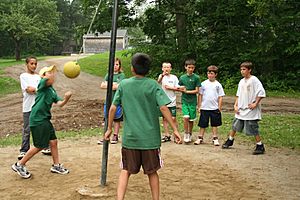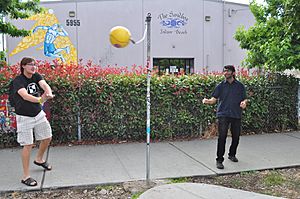Tetherball facts for kids
Tetherball is a fun outdoor game played by two people. It's not an official sport, but it's very popular on playgrounds and in backyards. The game uses a tall pole with a rope attached to the top. A volleyball is tied to the end of the rope. Players stand on opposite sides of the pole. They hit the ball to try and wrap the rope around the pole in their direction. The game ends when one player wraps the ball all the way around the pole. The ball must touch the pole and not bounce.
Contents
How to Play Tetherball
Tetherball is easy to learn and fun to play. Here's how a game usually starts and continues.
Starting the Game
To begin, one player serves the ball. They can hit it off the pole or simply hit it in their chosen direction. The other player then tries to hit the ball back in the opposite direction. The main goal is to hit the ball so well that your opponent cannot change its direction. You can hit the ball with your fist or your open hand.
Understanding the Rules
Players must follow a few simple rules. If you step onto your opponent's side of the pole, that's a foul. Touching the rope instead of the ball is also a foul. You also can't hit the ball before it has gone around the pole. If you break a rule, the game usually pauses. The player who made the mistake might be out for that round. The game continues with the other player serving the ball.
Winning the Game
You win a game of tetherball by wrapping the ball completely around the pole. The ball must hit the pole at the end of the rope. For younger players, there's often a line on the pole. The ball must hit the pole above this line to count as a win. A match can include several games. If a player breaks a rule, they might lose that game. The next player then gets a turn to play.
Tetherball Equipment
To play tetherball, you need a few key items. These include a strong pole, a rope, and a special ball.
The Ball and Rope
The tetherball itself is similar in size to a volleyball. However, it is usually a bit firmer. Tetherballs often have a special bar at the top. The rope ties to this bar. Sometimes, there are loops instead, but these can hurt your hand if you hit them. The rope is usually thin and made of nylon. It needs to be long enough so the ball hangs about 2 feet (0.6 meters) above the ground.
The Pole
The pole for tetherball is usually about 10 feet (3 meters) tall. For younger players, it can be as low as 7 feet (2.1 meters). To keep the pole steady, it's often set in the ground. Sometimes, it's held in place by a heavy base. This base might be filled with concrete, sand, or water.
Playing Surface
Tetherball can be played on many different surfaces. These include sand, gravel, lawn, or asphalt. This makes it a very flexible game for various outdoor spaces.



